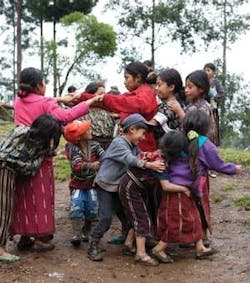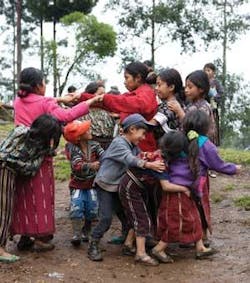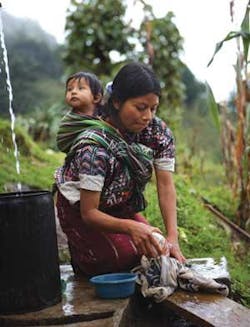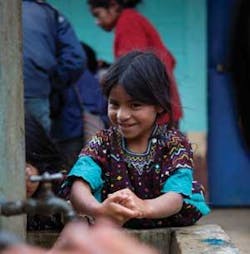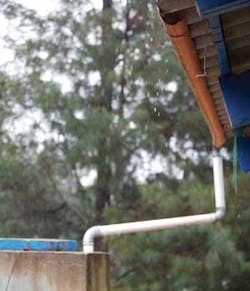A Natural Solution Catching Rain in Visivan, Guatemala
By David Stevenson
Water For People program helps make rainwater harvesting simple and safe for Central American village.
Amid a light but constant sheet of rain, two young smiling Mayan girls stand in a schoolyard. One in a red coat, the other in pink, both wearing rich, hand-woven skirts stopping just above their ankles. Leaning toward each other, hands joined, they form a bridge for all the pushing, squealing smaller children to squirm playfully through below. Off to the side two young boys play tag, slipping and sliding as they shift directions in the mud.
Nearby, the rain falls on the corrugated tin roof of their schoolhouse, rolls down into a gutter that collects and funnels it into a pipe that gravity feeds it into the cistern that sits below by the school building. Filled, the 500+ gallons of water can be used for drinking as well as washing children’s muddy hands.
All photos by Tim Ryan/www.timryanpictures.com
Here in the small village of Visivan, rain is an almost daily reality. The village is situated in the mountains, 11,500 feet above sea level, and receives over 100 inches of rain a year. But before the recently completed Water For People-supported rain catchment project (and associated cisterns), when the rains came, the waters were lost, rolling freely down the mountainside.
To meet family needs for drinking, washing clothes, dishes and bathing, villagers often walked 20 to 30 minutes each way carrying heavy jugs of water gathered from natural springs. These trips might be made as many as five times a day. Unfortunately, the water they collected was often unsafe and carried microbiological contaminants that could cause diarrhea and other debilitating, even deadly diseases.
Searching for a Solution
Mayan people have populated the rich, rugged peaks and valleys of the Cuchumantes Mountains in Guatemala’s Western Highlands for millenia. Like the rains, disease and death were felt to be natural as well, until last year. That’s when the village leaders contacted Water For People partner Aqua Para la Salud – a local non-governmental organization (NGO) – to support them in pursuing a practical, affordable solution to help meet Visivan’s water needs.
Various political candidates had promised the people of Visivan a water system for years, but a lack of groundwater and uncooperative landowners unwilling to sell or share their springs meant the promises never came true. Following a study, it was determined rainwater catchment tanks would be the most effective technology for the community.
The rain catchment solution was as natural as it was simple. It involved attaching PVC gutters to the roofs of individual homes (and the school) to catch rainwater during rainy months. A PVC pipe was attached to the gutter to feed the rainwater to a closed concrete cistern constructed next to each house. The cistern can hold up to 530 gallons of water and would have one or more faucets.
This solution provides a plentiful, convenient supply of water during the long rainy season and helps bridge supply needs during dry months. As a precaution, villagers are encouraged to boil collected rainwater for drinking and cooking to ensure its safety. Such rainwater harvesting reduces a community’s reliance on unsafe, remote water sources and enables villagers to concentrate on more productive endeavors.
Building It Together
Together, the community and Aqua Para la Salud representatives developed a project proposal. It included a work plan that identified how community members would be involved, what contribution they could provide and how the community would help maintain the system once installed.
The NGO would provide technical assistance, materials, hygiene education training and skilled labor. Visivan residents were to provide additional local materials, construction labor and participate in hygiene education training. Water For People was contacted and agreed to help fund the project and assist with its implementation.
The project began Jan. 3, 2007, and was completed May 4, 2007. Aqua Para la Salud masons began by training various Visivan residents to help train other village participants. Each homeowner was involved in the construction of their rain catchment gutters, pipes and cisterns. Everyone pitched in, including the children, to complete the rain catchment system for the school. It was a project begun and completed together with the goal of creating a safe water supply for all. The end result was a stronger community.
Rain Catchment and More
Now, all 31 families and the school have a convenient water source at their fingertips all year long. This means families such as that of Juan Ramirez, a teacher in the school, his wife Catarina de Paz Matom, and their four children can spend more time together. The rain catchment system frees Juan up to spend more time planting corn, black beans and vegetables in his garden for his family. Catarina can focus more on her weaving and caring for the children. And the children are free to go to school – and play and laugh as much as they wish.
A hygiene education program helped school children learn the importance of hand washing, and how and when to wash their hands effectively. The hygiene component was important for teaching villagers the basic steps (boiling, solar disinfection) to follow during dry seasons, when the cisterns run low, to ensure the water they gather from other sources is clean and safe as well. Families learned the importance of household cleaning, dishwashing and personal hygiene.Additionally, they learned more about sanitation, various common diseases and how to recognize them.
With less time spent gathering water and armed with more knowledge about hygiene, families are spending less money on healthcare and more on food, education and clothing.
All the Difference
The Visivan rain catchment project is about more than year-round access to clean water. It’s about empowering a community and responding to people’s desire to meet their own water needs in a way that fits their particular situation. Community members participated in the process, which gave them ownership and an ability to sustain their system for the long term. In addition, the hygiene education component helped inform the whole community and changed habits, ensuring good health for generations to come.
We’re sure the laughter of little children will continue to echo through these high mountains far into the future. And we know their simple, natural rain catchment solution will continue to enhance their quality of life.
Author’s Note:
A freelance writer who lives in Denver, Colorado, USA, David Stevenson has participated in numerous community work projects with the people of the Dominican Republic, Venezuela and the San Luis Valley in southern Colorado – and now Guatemala
Contact: www.waterforpeople.org
